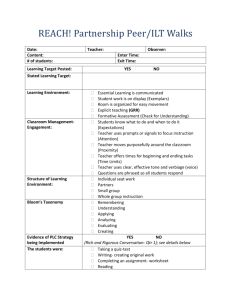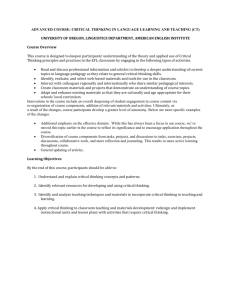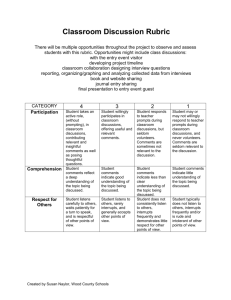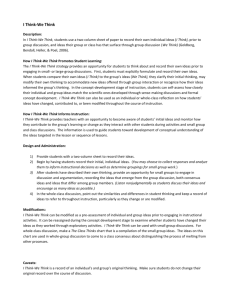Sharing and making perspectives in web-based conferencing
advertisement
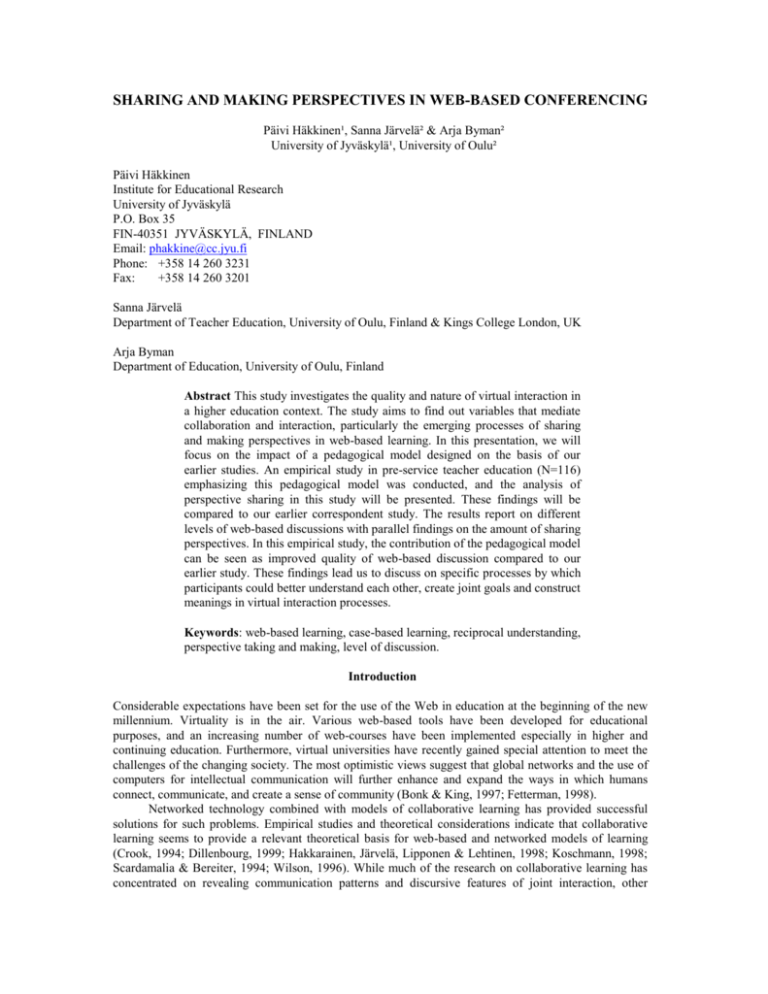
SHARING AND MAKING PERSPECTIVES IN WEB-BASED CONFERENCING Päivi Häkkinen¹, Sanna Järvelä² & Arja Byman² University of Jyväskylä¹, University of Oulu² Päivi Häkkinen Institute for Educational Research University of Jyväskylä P.O. Box 35 FIN-40351 JYVÄSKYLÄ, FINLAND Email: phakkine@cc.jyu.fi Phone: +358 14 260 3231 Fax: +358 14 260 3201 Sanna Järvelä Department of Teacher Education, University of Oulu, Finland & Kings College London, UK Arja Byman Department of Education, University of Oulu, Finland Abstract This study investigates the quality and nature of virtual interaction in a higher education context. The study aims to find out variables that mediate collaboration and interaction, particularly the emerging processes of sharing and making perspectives in web-based learning. In this presentation, we will focus on the impact of a pedagogical model designed on the basis of our earlier studies. An empirical study in pre-service teacher education (N=116) emphasizing this pedagogical model was conducted, and the analysis of perspective sharing in this study will be presented. These findings will be compared to our earlier correspondent study. The results report on different levels of web-based discussions with parallel findings on the amount of sharing perspectives. In this empirical study, the contribution of the pedagogical model can be seen as improved quality of web-based discussion compared to our earlier study. These findings lead us to discuss on specific processes by which participants could better understand each other, create joint goals and construct meanings in virtual interaction processes. Keywords: web-based learning, case-based learning, reciprocal understanding, perspective taking and making, level of discussion. Introduction Considerable expectations have been set for the use of the Web in education at the beginning of the new millennium. Virtuality is in the air. Various web-based tools have been developed for educational purposes, and an increasing number of web-courses have been implemented especially in higher and continuing education. Furthermore, virtual universities have recently gained special attention to meet the challenges of the changing society. The most optimistic views suggest that global networks and the use of computers for intellectual communication will further enhance and expand the ways in which humans connect, communicate, and create a sense of community (Bonk & King, 1997; Fetterman, 1998). Networked technology combined with models of collaborative learning has provided successful solutions for such problems. Empirical studies and theoretical considerations indicate that collaborative learning seems to provide a relevant theoretical basis for web-based and networked models of learning (Crook, 1994; Dillenbourg, 1999; Hakkarainen, Järvelä, Lipponen & Lehtinen, 1998; Koschmann, 1998; Scardamalia & Bereiter, 1994; Wilson, 1996). While much of the research on collaborative learning has concentrated on revealing communication patterns and discursive features of joint interaction, other characteristics influencing learning and interaction in the context have received less attention (Arvaja, Häkkinen, Eteläpelto & Rasku-Puttonen, 2000). There is still a need for studies on the necessary conditions and prerequisites for successful collaboration in networked environments. Furthermore, we have to investigate what it is that raises the need for collaboration. Recent studies have revealed that in connection with corresponding pedagogical practices, CSCL (Computer-Supported Collaborative Learning) environments can facilitate higher-level cognitive achievements in educational settings (Edelson, Pea & Gomez, 1996; Hakkarainen et al., 1998; Scardamalia & Bereiter, 1994). However, in spite of successful instructional design work among cognitive learning theorists, growing evidence still demonstrates that communication in web-based learning environments does not usually facilitate theory-based reflections and argumentation but mostly experience- and feelings-based discussion. Furthermore, most research on the use of web-based communication tools in training and working settings still lacks theoretical grounding in contemporary learning theory (Koschmann, 1994). Our own studies indicate that the quality of meaningful web-based interaction and learning varies a lot (Järvelä & Häkkinen, 2001a, 2001b; Saarenkunnans, Järvelä, Häkkinen, Kuure, Taalas, & Kunelius, 2000). To conclude, much of the current research is contradictory, inconclusive and possibly misleading, and there are often overly optimistic claims about technology-based projects (Fabos & Young, 1999). Sharing perspectives Theories on social interaction and learning (Doise & Mugny, 1984; Markova, Grauman & Foppa, 1995) as well as discourse theories (Potter & Wetherell, 1989) have given insight on the specific processes of human interaction as negotiation of meaning. Numerous studies report on perspective-taking, reciprocal understanding, negotiation of joint goals and grounding as well as on the dynamics of power and distance in synchronous communication. However, our hypothesis is that in order to move to successful web-based learning and virtual interaction in education we need to know more on the basic processes of human interaction, and on how to use that knowledge to promote the quality of virtual interaction in networked technology contexts. With these notions we intend to gain knowledge on the emerging processes of sharing and making perspectives in virtual interaction, and on the possible contextual and pedagogical features which effect on the quality of web-based learning and increase its educational value. Virtual interaction without immediate social interaction has many challenges to overcome since communicating parties are faced continuously with the task of constructing their common cognitive environment. The absence of visual information (e.g. missing facial expressions and nonverbal cues) reduces the richness of the social cues available to the participants, increasing the social distance. For people to communicate effectively, they must solve the mutual knowledge problem (Graumann, 1995; Krauss & Fussell, 1990; Nystrand, 1986). It seems evident that people acquire knowledge and patterns of reasoning from one another but for some kinds of shared knowledge, individually rooted processes play a central role. In the grounding phase of co-ordinated problem solving, the participators negotiate about common goals, which means that they do not only develop shared goals but they also become mutually aware of their shared goals (Crook, 1994; Gay & Lentini, 1985). Pedagogical model Following the principles of interventions studies in authentic context (Brown 1992) we have developed a pedagogical model supporting the interactors' perspective sharing in web-based learning. The pedagogical model is based on our previous studies on networked interaction and case-based model in conferencing on a web (Järvelä & Häkkinen, 2001a; Saarenkunnas et al., 2000). In terms of designing pedagogical implications to enhance high-quality virtual interaction we will emphasize the following principles, which base on the theoretical framework adopted in this study (see Figure 1). 1. 2. 3. Problem-oriented case-work was established (Bereiter & Scardamalia, 1993). Students had to redefine the original problem as well as to summarise and to reflect the discussion during the course. Group reflection was promoted by metawork (Häkkinen, Järvelä & Dillenbourg, 2000). The students’ awareness of individual and group processes in the virtual community was raised with on-line web-questionnaires. Awareness of perspective sharing and negotiation of joint goals was supported by participant observation (Silverman, 1993). The role of face-to-face meetings was essential for the grounding process throughout the course. Figure 1. Pedagogical model for SHAPE (Shared Perspectives in Virtual Environments) Aims The purpose of this study is to report the results on the analysis of sharing and constructing perspectives in web-based learning, and to compare the findings of perspective taking levels in two of our empirical studies. Research design Subjects The subjects of the study are pre-service teachers in the USA, University of Indiana (N=67), Great Britain, University of Warwick (N=9) and Finland, Universities of Jyväskylä (N=19) and Oulu (N=21). For all these students, the participation in web-based conferencing course is credited as part of their compulsory studies in education. All the students had experiences with field training, studies in educational psychology, and basic knowledge about computers and Internet. This Web-based project lasted for three months. Task and tools Students used an asynchronous web-based learning environment called ProTo to construct case-based descriptions in the areas such as learning context or technology in education as well as the change these practices impose on the traditional teaching and learning practices. Each case could have been either a success story or a description of a problematic teaching scenario based on fieldwork observations of ‘theory in action’. For example, students were asked to describe a teacher and/or student(s) in a problematic or instructionally interesting situation observed in the field; leaving all the names and places of the situation anonymous. Different levels of expertise in peer and mentor collaboration were provided during the learning process in order to apprentice student learning. Mentoring was organized by senior students in other countries as well as by in-service teachers and faculty members from other universities. In order to strengthen the feeling of a virtual community, the web-work was supported by videoconferences between different sites. In these conferences, the process of creating cases was discussed (See Saarenkunnas et al., 2000). Method Data collection A combination of quantitative and qualitative research methods were employed. Quantitative data included: 1) computer-generated usage of statistics that illuminate the nature, time and volume of participation (the amount of messages, replays, frequencies etc.), as well as the distribution of discussions among the users; 2) survey data on subjects’ background information; 3) various interviews during the process and; 4) transcript data of students postings. This paper reports on data set 1 and 4. Data analysis At first a preliminary analysis of each discussion was conducted and the types of postings were grouped into the following categorizations: Theory / New point, Question / Experience / Suggestion / Comment. After that cross-references between the student postings within discussions, and mentors’ postings were marked. Moreover quantifications were made such as, the number of postings by mentors, the number of each type of posting and the number of cross-references. The second phase of the analysis focused on the level of discussions. During the three months period the students produced 40 different discussions involving 5-25 postings in each discussion. Graphs were drawn, which demonstrate the progress of a discussion, dynamics of different types of postings, mentors’ role and cross-referring in each discussion. The graphs were researchers’ analytic tools, which facilitated formulating three groups of all the discussions: high-level discussions, progressive discussions and low-level discussions. Two researchers made independent estimates of levels of discussions. Their classifications matched perfectly with 90 % of codings. The 10 % of contradictory analyses (3 discussions) were negotiated until unitary estimation was reached. Finally the specific analysis of a quality of communication: a stage of perspective taking in discussions was performed, since we assumed that an important construct for reciprocal interaction is perspective taking. The particular attempt was to find out what stage of perspective taking occurs among the students in asynchronous discussion. Based on Piaget’s cognitive developmental theory, Selman (1980) has outlined a social cognitive developmental model of five distinct stages with increasing abilities to take into account alternative viewpoints. The developmental levels of the co-ordination of social perspectives are: Stage 0: Undifferentiated and Egocentric, Stage 1: Differentiated and Subjective RoleTaking; Stage 2: Self-Reflective/Second Person and Reciprocal Perspective, Stage 3: Third-Person and Mutual Perspective Taking, and Stage 4: In-depth and Societal-Symbolic Perspective Taking. In our study, Selman’s (1980) perspective taking categories were adapted to developing a coding category for exploring the quality of asynchronous electronic discussion (for more details see Järvelä & Häkkinen, 2001b). It was created so that after studying the theoretical basis of perspective taking, the researchers made the first draft of the category system so that they discussed the most typical elements of electronic discussion in general and in different perspective-taking stages in particular. The category system was revised after becoming familiar with the data of students’ web-based discussions, so that the contextual features of the electronic discussion were involved (See Järvelä & Häkkinen, 2001b). Two researchers made independent estimates also for coding of perspective-taking stages, and this time classification matched perfectly in 80 % of coding. The 20 % of contradictory analyses were discussed until unitary estimation was reached. Results Three levels of web-based discussion were found: high-level discussions, progressive discussions and lowlevel discussions. More specific analysis of the quality of each level conversation focused on perspective taking in communication. Next we will present the results of this study (Study 2) and compare them to our earlier study (Study 1). In general, the results of this study point out higher levels of web-based discussion and higher stages of perspective taking than the results of our first study (Järvelä & Häkkinen, 2001a). Therefore, we assume that the contribution of the pedagogical model can clearly be noticed. Types of postings During a three months period the students produced 38 different case discussions in the ProTo environment, which had altogether 457 postings. In the first phase of the data analysis, postings were categorised into five different groups: theory-based posting, new point or question, experience, suggestion and comment. Of all postings, 20% were theory-based postings, 44% were either a question or a new point, 11 % of them were experiences, 19% suggestions and 6% comments. Compared to the Study 1, the amount of theory-based postings and new points or questions was higher whereas the amount of comments was clearly decreased (see Figure 2). Theory 20 9 New point / Question 11 Experience Suggestion Comment 44 20 6 6 20 19 Study 2 Study 1 45 0 20 40 60 Percents Figure 2. Types of postings in Study 1 and Study 2. Level of discussion The categorising of discussions into three different groups according to their educational value indicated that 53% of discussions were high-level discussions, 42% progressive discussions and 5% low-level discussions. High–level discussions could be characterised as shared theory-based discussions involving a lot of theory-based postings as well as new points or questions. Rich cross-referring between postings was also typical. Progressive discussions also involved some cross-references, generalisations and joint ”knowledge-building” but also plenty of comments, experience-based postings and postings with new points or questions. However, no theory-based discussion occurred. Low-level discussions involved mainly separate comments and opinions. Students’ comments did not take into consideration the earlier discussion but rather represented each student’s independent and often unilateral comments. Compared to the Study 1, these results also indicated improved level of web-based discussion. Especially the amount of high-level discussions was increased and the amount of low-level discussions decreased (see Figure 3). 53 High-level 24 42 40 Progressive Study 2 Study 1 5 Low-level 36 0 20 40 60 Percents Figure 3. Level of discussion in Study 1 and Study 2. Perspective-taking stage in discussions Discussions were also analysed trough categories based on the socio-cognitive perspective taking theory. From all 38 discussions, 3% reached the highest stage (stage 4), Societal-Symbolic Perspective Taking. Typical for this kind of discussions was that students abstracted multiple mutual perspectives to a societal, conventional, legal or moral perspective, which all the individuals could share. The most typical category of perspective taking in the Study 2 was Mutual Perspective Taking (stage 3) (71 %), which meant that the topic of discussion was seen from the third person or generalized other perspective. The discussion typically progressed from mutual experiences (my points) to more elaborative argumentation, and developed to discussions about more general points in education or society, for example. The stage 2, Reciprocal Perspective Taking occurred in 21 % of the discussions. These discussions represented twoway reciprocity in thoughts and feelings, not merely in actions, but different perspectives were not taken into account enough. The lowest stage (stage 1) of perspective taking in Study was Subjective RoleTaking (5 %) where students’ opinions, experiences and feelings were unitary, and they responded to postings of discussion with alike postings. None of the discussions in Study 2 stayed at the lowest stage (stage 0) of perspective taking theory (Egocentric) where students would just present subjective and egocentric expressions, and postings would remain scattered. Compared to the Study 1, these results represented higher stages of perspective taking. Especially the proportion of Mutual Perspective Taking was higher in this second study. One discussion (3 %) also reached highest stage of perspective taking (Societal-Symbolic Perspective Taking), the stage which did not occur at all in the Study 1. In the Study 1, 8 % of the discussions were categorized at the lowest stage (Egocentric), whereas none of the discussions in the Study 2 stayed at this stage. 3 0 Societal-Symbolic Perspective Taking Mutual Perspective Taking 20 21 Reciprocal Perspective Taking 5 Subjective Role-Taking 0 Egocentric 0 71 36 36 Study 2 Study 1 8 20 40 60 80 Percents Figure 4. Stages of perspective-taking in Study 1 and Study 2. The relation between level of discussion and perspective-taking stage In general, the results in both studies indicate that high-level discussions involved communication with highest stage of perspective taking and constructive discussion, while low-level discussions were mostly egocentric and superficial. In this second study, the discussions, which were educationally at the higher level, were either at the stage 4, stage 3 or stage 2. Most of them (18 discussions) were at the stage 3 (Mutual Perspective Taking). One of the high-level discussions was at the stage 4 (Societal-Symbolic Perspective Taking) and one at the Stage 2 (Reciprocal Perspective Taking). The progressive level of discussions (16) were either at the stage 3 or at the stage 2. Nine of the discussions were at the Mutual Perspective Taking stage (the stage 3) and seven at the Reciprocal Perspective Taking stage (the stage 2). The low-level discussions (2) stayed at the Subjective Role-taking stage (the stage 1). Discussion Since perspective taking skills are critical to successful human functioning and involvement in everyday social interaction, we suppose that global networks can give an impact on student perspective taking and raise interpersonal understanding. The aim of this study was to analyse educational quality of web-based discussions through theory-based analysis of perspective taking stages. The results show that during this particular course the participants formed a lot of reciprocal discussion. The results show that 71% of discussions reached the stage of Mutual Perspective Taking (stage 3). Participants had mutual negotiations in their web-based communication and they discussed about issues from variety of different viewpoints. In this study, it was assumed that the higher stage of perspective taking is in the discussions, the more there is reciprocal understanding in discussions. The levels of educational value supported also the claim of that the reciprocal understanding is an important fact for reaching the educationally high-level discussion. The discussions with mutual negotiations and cross-references were at the higher level as far as educational quality was concerned. The reasons for such high amount of reciprocity in web-based discussions could be in the pedagogical context of this particular course. Particular focus was on pedagogical model emphasizing problem-oriented case-work as well as reflection of individual and group processes during the course. Furthermore, creation of shared beliefs and values are hard to reproduce in web environment without intensive face-to-face meetings (Roschelle & Pea, 1999). During this course, the students alternately had face-to-face meetings and computer-based work. It could be that the face-to-face meetings supported participants’ contributions so that the discussions become more reciprocal. The students were able to express their opinions, beliefs, and assumptions during the face-to-face meetings. As Baker, Hansen, Joiner and Traum (1999) have emphasised, common ground of mutual understanding has been claimed to be necessary for collaboration. On the basis of this study, it seems evident that interaction processes are not inherently situated in a web-based environment, nor is knowledge construction derived exclusively from writings or notes on a web. Web-based learning should not be considered only in global networks, but should be seen in a broader social context. These results prompt us to further consider the role of different contextual resources, particularly pedagogical practices, in the creation of shared understanding. Furthermore, in order to support higher learning, the pedagogical models for web-based interaction should be based on a solid base of learning theory. It is expected that this study will provide gradually specifying information about how the participants better understand each other, create joint goals and construct meanings in virtual interaction processes. References Arvaja, M., Häkkinen, P., Eteläpelto, A. & Rasku-Puttonen, H. (2000). Collaborative processes during report writing of a science learning project: The nature of discourse as a function of task requirements. European Journal of Psychology of Education, 15(4), 457-462. Bereiter, C. & Scardamalia, M (1993). Surpassing ourselves. An inquiry into the nature and implications of expertise. Chicago, IL: Open Court. Baker, M., Hansen, T., Joiner, R. & Traum, D. (1999). The role of grounding in collaborative learning tasks. In: P. Dillenbourg (Ed.), Collaborative learning: cognitive and computational approaches (pp. 31-63). Pergamon: Oxford. Bonk, C. J. & King, K. S. (Eds.). (1998). Electronic collaborators: Learner-centered technologies for literacy, apprenticeship, and discourse Mahwah, NJ: Erlbaum. Brown, A. L. (1992). Design experiments: Theoretical and methodological challenges in creating complex interventions in classroom settings. The Journal of the Learning Sciences, 2, 141-178. Crook, C. (1994). Computers and the collaborative experience of learning. Routledge: London & New York. Edelson, D. C., Pea, R. D. & Gomez, L. (1996). Constructivism in the collaboratory. In B. G. Wilson (Ed.), Constructivist learning environments: Case studies in instructional design (pp. 151-164). Englewood Cliffs, NJ: Educational Technology Publications. Dillenbourg, P. (1999). Introduction: What do you mean by collaborative learning? In: P. Dillenbourg (Ed.), Collaborative learning: cognitive and computational approaches (pp.1-19). Pergamon: Oxford. Doise, W. & Mugny, G. (1984). The Social Development of the Intellect. Oxford: Pergamon. Fabos, B. & Young, M.D. (1999). Telecommunication in the classroom: Rhetoric versus reality. Review of Educational Research, 69(3), 217-259. Fetterman, D.N. (1998). Webs of meaning: Computer and Internet resources for educational research and instruction. Educational Researcher, 27(3), 22-30. Gay, G. & Lentini, M. (1995). Use of collaborative resources in a networked collaborative design environment. Journal of Computer-Mediated Communication, 1, 1-12. Graumann, C. F. (1995). Commonality, mutuality, reciprocity: A conceptual introduction. In I. Markova, C. Graumann & K. Foppa (Eds.), Mutualities in dialogue (pp. 1-24). New York, Cambridge University Press. Hakkarainen, K., Järvelä, S., Lipponen, L. & Lehtinen, E. (1998). Culture of collaboration in computersupported learning: Finnish perspectives. Journal of Interactive Learning Research, 9, 271-288. Häkkinen, P., Järvelä, S. & Dillenbourg, P. (2000). Group Reflection Tools for Virtual Expert Community - REFLEX Project. In B. Fishman & S. O'Connor-Divelbiss (Eds.), Proceedings of the Fourth International Conference of the Learning Sciences (pp. 203-204). Mahwah, NJ: Erlbaum. Järvelä, S. & Häkkinen, P. (2001a). Web-based cases in teaching and learning – the quality of discussions and a stage of perspective taking in asynchronous communication. Interactive Learning Environments. In press. Järvelä, S. & Häkkinen, P. (2001b). The levels of web-based discussions – using perspective-taking theory as an analysis tool. In H. van Oostendorp (Ed.), Cognition in a digital world. Lawrence Erlbaum. In press. Koschmann, T. D. (1994). Toward a theory of computer support for collaborative learning. Journal of Learning Sciences, 3(3), 219-225. Krauss, R. M. & Fussell, S. R. (1990). Mutual knowledge and communicative effectiveness. In J. Galegher, R.E. Kraut, & C. Egido (Eds.), Intellectual teamwork (pp. 111-145). Hillsdale N.J., Lawrence Erlbaum. Markova, I., Graumann, C. & Foppa, K. (1995) Mutualities in Dialogue. New York: Cambridge Universty Press. Nystrand, M. (1986). The structure of written communication: Studies of reciprocity between writers and readers. London: Academic Press. Potter, J. & Wetherell, M. (1989). Discourse and Social Psychology: Beyond Attitudes and Behavior. London: Sage. Roschelle, J. & Pea, R. (1999). Trajectories from today’s WWW to a powerful educational infrastructure. Educational Researcher, 43, 22-25. Saarenkunnas, M., Järvelä, S., Häkkinen, P., Kuure, L., Taalas, P. & Kunelius, E. (2000). NINTER Networked interaction: theory-based cases in teaching and learning. Learning Environments Research. In press. Scardamalia, M. & Bereiter, C. (1994). Computer support for knowledge building communities. The Journal of Learning Sciences, 3, 265-283. Selman, R. L. (1980). The growth of interpersonal understanding. New York: Academic Press. Silverman, D. (1993). Interpreting qualitative data. Methods for analysing Talk, Text and Interaction. London: Sage. Wilson, B.G. (1996). Constructivist learning environments: Case studies in instructional design (pp. 151164). Englewood Cliffs, NJ: Educational Technology Publications



